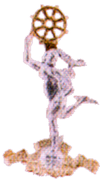- Sri Lanka Signals Corps
-
Sri Lanka Signals Corps 
Cap badge of the Sri Lanka Signals CorpsActive 19 October 1943 - Present Country Sri Lanka Branch Sri Lanka Army Type Signals Corps Role Military communications,
Electronic warfare,
Information technology supportSize 4 regular signal regiments,
5 regular signal RFT units,
1 EW Squadron,
1 volunteer regiment
School of Signals,
Signal Base WorkshopRegimental Centre Army Cantonment, Panagoda, Homagama. Nickname SL Signals Motto "Certa Cito" Latin - (Sure and Swift). Colors Sky Blue, Navy Blue and Olive Green March Begone Dull Care Anniversaries 19 October Engagements World War II
1971 Insurrection
Insurrection 1987-89
Sri Lankan Civil WarCommanders Ceremonial chief Brigadier TF Meedin RSP (bar) Ldmc (MMS, MIT) The Sri Lanka Signals Corps (SL Signals) a combat support corps of the Sri Lanka Army, responsible for providing military communications, information technology and electronic warfare support. The corps is made up of nine regular regiments and one volunteer (reserve) regiment. It is responsible for installing, maintaining and operating all types of telecommunications equipment and information systems. It is headquartered at Panagoda Cantonment, Panagoda.
The Colonel Commandant of the SL Signals is Brigadier TF Meedin, who is also the Chief Signal Officer (CSO) and Chief Innovations Officer (CIO) of the Sri Lanka Army. Colonel K.R.P. Rowel is Commander Signals Brigade operationally in charge of all classic units and sub-units in the field.
The flag and cap badge feature Mercury, the winged messenger of the gods, who is referred to by members of the corps as "Jimmy".
Contents
History
Established on October 19, 1943 as a part of the Ceylon Defence Force it was reformed as a troop of signals February 9, 1950 following the formation of the Ceylon Army in 1949. The initial task of this troop was to provide communications between Army HQ and its branches. In 1949, the Volunteer Signals unit was commanded by Lt Col CR De Silva. By the end of 1950 this troop had 1 Officer and 17 other ranks and their tasks included establishing a signals office at Army HQ, provision of a signal dispatch service, manning a switch board and the construction and maintenance of underground as well as field cables. In May 1951 another Signals Office was established in Diyatalawa to serve the Garrison HQ which was just formed at that time. By October 1, 1951 the troop was raised to a squadron with a strength of 4 Officers and 142 other ranks.
In 1951 formal approval was granted to wear the Royal Signals badges with the additional scroll CEYLON on it and to adopt the Royal Signals march Begone Dull Care as the regimental march of the Ceylon Signals Corps and in 1959 the 1 st Regiment of the Ceylon Signals was formed with Lt Col DV. Brohier was appointed as its first Commanding Officer. In 1962 following the attempted military coup the 2nd volunteer signal regiment was disbanded and its remaining personnel transferred to form the National Service Regiment (NSR).
In 1972 with Sri Lanka proclaiming itself a republic, the Corps was renamed as the Sri Lanka Signals Corps. In 1980 a new Volunteer squadron was raised. The Corps has expanded to a level of a Signals Brigade with integral signals units under HQ Chief Signal Officer at the highest level of command in performing the classic role. The Signals Corps provides support to the combat and support arms by providing communications, electronic warfare and information technology support in the battle field and at the rear. Five signals regiments have been raised to function as RFT units. All these signal units and sub-units administratively come under the aegis of the Regimental Centre located at Panagoda.
Units
Regular Regiments
- 1st Regiment SLSC
- 3rd Regiment SLSC
- 4th Regiment SLSC
- 5th Regiment SLSC (RFT)
- 6th Regiment SLSC (RFT)
- 7th Regiment SLSC (RFT)
- 8th Regiment SLSC (RFT)
- 9th Regiment SLSC
- 10th Regiment SLSC (RFT)
- AHQ Independent Signal Squadron
- Signal Base Work Shop
- School of Signals
- Information Techonology Unit
Volunteer Regiments
- 2nd Regiment SLSC (Volunteers)
Notable members
- Lieutenant Colonel Gotabhaya Rajapaksa, RWP, RSP, GR - Permanent Secretary Ministry of Defence, Public Security, Law & Order (1st commissioned to SLSC in 1972)
- Major General WJTK Fernando, psc - former CO, 1SLSC
- Major General CJ Abayaratna, VSV, USP - 1st Colonel Commandant, SLSC, former Signals Brigade Commander & former CO, 1SLSC
- Major General AMCWB Senewiratne, VSV, USP, psc - 4th Colonel Commandant, SLSC & former CO, 3 SLSC
- Major General YSA de Silva, USP - 5th Colonel Commandant, SLSC, former Sig Brigade Commander & former CO 4 SLSC
- Lieutenant Colonel DV Brohier - First Commanding Officer, Ceylon Signals Corps
- Lieutenant Colonel Basil R Jesudasan - former Commanding Officer, 2nd Volunteer Signals, Ceylon Signals Corps & accused conspirator in the 1962 coup d'état attempt
- Lieutenant Colonal R Elvitigala - Commanding officer 1st Regiment Sri Lanka Signal Corps
Alliances
Order of precedence
Preceded by
Sri Lanka EngineersOrder of Precedence Succeeded by
Sri Lanka Light InfantrySee also
External links and sources
Armed Forces of Sri Lanka Regiments and corps of the Sri Lanka Army Combat Arms Armoured Corps · Light Infantry · Sinha Regiment · Gemunu Watch · Gajaba Regiment · Vijayabahu Regiment · Mechanized Infantry · President's Guard · Commandos · Special Forces · Rifle Corps · National GuardSupport Arms Support Services Disbanded Ceylon Mounted Rifles · Ceylon Planters Rifle · Ceylon Railway Engineer · Ceylon Rifle · Colombo Town Guard · National Service Regiment · Post and Telegraph Signals · Rajarata Rifles · Ruhunu RegimentCategories:- Regiments of the Sri Lankan Army
- Telecommunications in Sri Lanka
- Military communications
Wikimedia Foundation. 2010.
